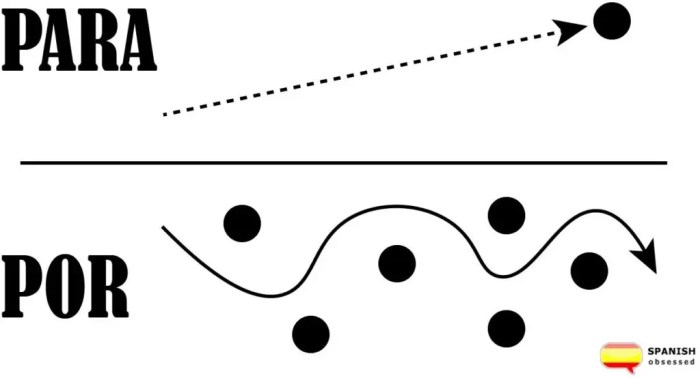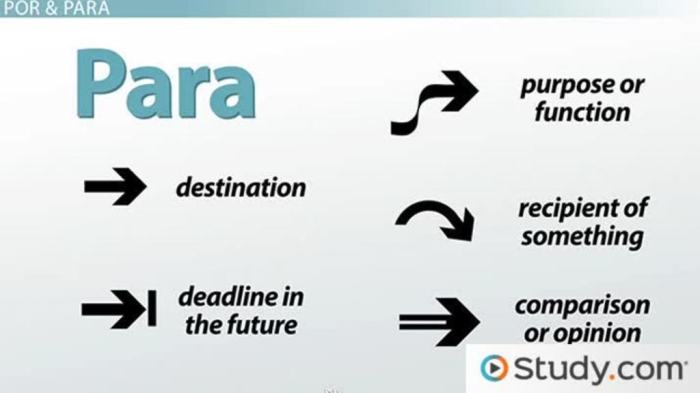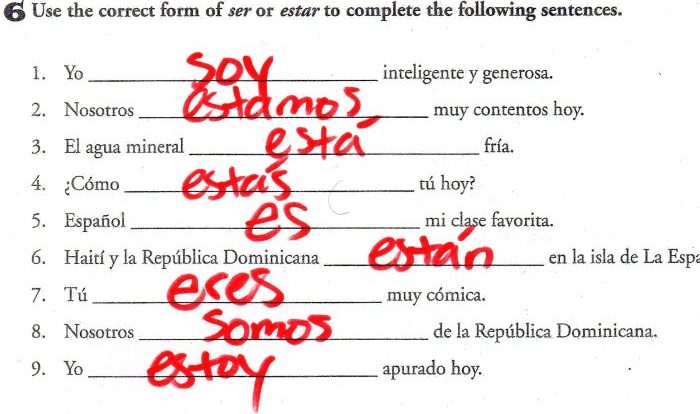Los usos de por y para worksheet answers – Embarking on an exploration of “los usos de por y para”, this guide unveils the intricate tapestry of these Spanish prepositions. With a focus on clarity and precision, we delve into the distinct nuances of “por” and “para”, providing a comprehensive understanding of their usage and application.
Through illustrative examples and a comparative analysis, we illuminate the specific contexts where each preposition reigns supreme, empowering learners to navigate the complexities of Spanish grammar with confidence.
Understanding the Usage of “Por” and “Para”: Los Usos De Por Y Para Worksheet Answers

In Spanish, the prepositions “por” and “para” are essential for expressing a wide range of meanings. Understanding their distinct uses is crucial for accurate communication.
The primary difference between “por” and “para” lies in their fundamental functions:
- “Por” is primarily used to indicate a period of time, a reason or cause, or a means or instrument.
- “Para” is mainly employed to express a purpose or goal, a recipient or destination, or a deadline or future point in time.
Specific Contexts for “Por”, Los usos de por y para worksheet answers
Period of Time:
- Por la mañana(in the morning)
- Por tres días(for three days)
Reason or Cause:
- Por favor(please)
- Por eso(therefore)
Means or Instrument:
- Por correo electrónico(by email)
- Por teléfono(by phone)
Specific Contexts for “Para”
Purpose or Goal:
- Para estudiar(to study)
- Para el examen(for the exam)
Recipient or Destination:
- Para Juan(for John)
- Para México(to Mexico)
Deadline or Future Point in Time:
- Para mañana(by tomorrow)
- Para el próximo año(by next year)
Comparative Analysis of “Por” and “Para”
| Usage | Examples | Notes |
|---|---|---|
| Period of Time | Por la mañana (in the morning) | Used to indicate a duration or specific time |
| Reason or Cause | Por favor (please) | Expresses a request or reason |
| Means or Instrument | Por correo electrónico (by email) | Indicates the method or tool used |
| Purpose or Goal | Para estudiar (to study) | Expresses the intended use or objective |
| Recipient or Destination | Para Juan (for John) | Identifies the person or place receiving something |
| Deadline or Future Point in Time | Para mañana (by tomorrow) | Indicates a specific time or deadline |
Additional Notes and Exceptions
Exceptions:
- “Por” can also be used to express the idea of “in exchange for” (e.g., por dinero– for money).
- “Para” can be used to express the idea of “in order to” (e.g., para que– in order to).
Tips for Avoiding Common Mistakes:
- Remember that “por” is used for time periods, reasons, and means, while “para” is used for purposes, destinations, and deadlines.
- Pay attention to the context of the sentence to determine the correct preposition.
- Practice using both prepositions in various contexts to improve your fluency.
Frequently Asked Questions
What is the primary difference between “por” and “para”?
“Por” generally denotes a period of time, reason, or means, while “para” indicates purpose, destination, or deadline.
Can you provide an example of “por” expressing a reason?
Por ejemplo: Lo siento, no puedo ir a la fiesta por estar enfermo. (I’m sorry, I can’t go to the party because I’m sick.)
How do I use “para” to express a deadline?
Para el viernes, necesito terminar este proyecto. (I need to finish this project by Friday.)


